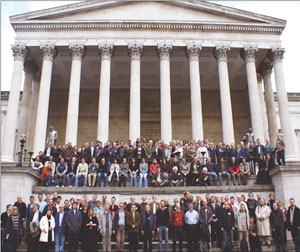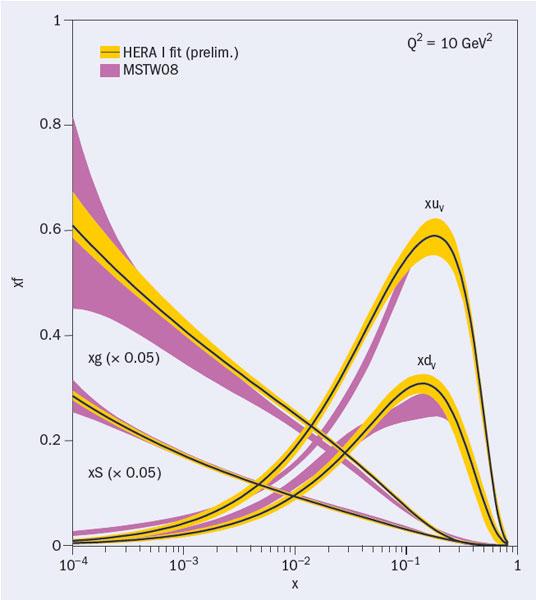A report from the meeting on deep-inelastic scattering and related topics.
This spring the XVI International Workshop on Deep-Inelastic Scattering and Related Subjects (DIS 2008) took place at University College London (UCL), and was jointly organized by the high-energy particle physics groups of the University of Oxford and UCL. Some 300 participants attended the workshop, which was held on 7–11 April and consisted of approximately 270 talks covering a multitude of subjects.
The provost and president of UCL, Malcolm Grant, opened the first day, which consisted mainly of plenary talks, with speakers detailing recent experimental and theoretical highlights, and looking at future developments in the field of deep-inelastic scattering (DIS), QCD and collider physics. The opening plenary speakers greatly helped to set the tone of the meeting with excellent overviews and positive outlooks. In the late afternoon, the workshop split into working groups with specialized talks, with up to six groups in parallel at any one time.

Image credit: Simon Bevan/UCL.
The parallel sessions covered a range of subjects, including structure functions and low-x; diffraction and vector mesons; electroweak measurements and physics beyond the Standard Model; hadronic final states and QCD; heavy flavours; spin physics; and future facilities. There were many excellent presentations, including high-quality results from both experiment and theory, together with extensive discussions. The parallel sessions continued throughout the next two days, culminating with a packed additional session organised by Hannes Jung from DESY on “What HERA can still provide”. That so many people were prepared to forego an evening meal to participate in an extra session at the end of a busy day demonstrates the unique legacy of HERA, the world’s first and only electron–proton collider, which ceased operation at DESY in June 2007. On the afternoon and morning of the final two days, the convenors of the working groups reported on the highlights of their sessions. Finally, Brian Foster of the University of Oxford beautifully summarized the whole workshop, again highlighting the vitality of both the field and the workshop.
Work on the structure of the proton – the main subject of the DIS workshop series – has seen tremendous advances recently. The H1 and ZEUS collaborations have made the first measurements of the longitudinal structure function, FL, and have combined data on inclusive DIS cross sections from the HERA I run in a preliminary HERA fit of the parton density functions. The quantity FL is an integral part of the description of the proton’s structure and is directly sensitive to the gluon density and the QCD evolution with momentum transfer. Both collaborations have measured FL using two special low-energy proton runs taken at the end of HERA data taking. While the data are consistent with QCD predictions of the parton densities, which are based on fits to the inclusive measurements of F2, they cannot yet distinguish between different predictions, although significant improvements to the measurements are expected.
Taking advantage of the different detectors and their systematics, the combination of the F2 measurements from H1 and ZEUS has produced results that are significantly more precise than the simple effect of doubling statistics. The effective “cross calibration” has led to uncertainties of 1–2% over a wide range in Bjorken-x and in photon virtuality, Q2. The combined HERA data alone have in turn been used in a fit of the parton distributions in the proton and this leads to results that are competitive with global fits that use data from many different sources (see figure). Data from the Tevatron at Fermilab are also placing strong constraints on the structure of the proton. Results on the charge asymmetry of the W particle from the CDF experiment have a precision that is significantly better than the uncertainties on the parton distribution functions. Additionally, inclusive-jet cross sections from the D0 experiment yield constraints at the highest scales, up to 600 GeV. They also provide a wonderful verification of QCD predictions across 10 orders of magnitude in the cross section, differential in jet pT and rapidity.
All of the above results are crucial inputs to our understanding of QCD, and in particular the structure of the proton, which is needed as the starting point for most of the physics at CERN’s LHC. Along with the new measurements, theory is keeping pace with a number of advances that are either already made or planned. With the recent development of next-to-next-to-leading order QCD corrections (NNLO) for F2, groups are working on the implementation of NNLO for general 2 &raar; 2 parton scattering and the extension to the next order for F2. Of course with every order in the perturbation expansion, the number of diagrams increases exponentially, but new approaches using formal mathematics developed for other applications, such as twistors, are helping to reduce the number of diagrams by over an order of magnitude.

Spin physics – fully polarized DIS – attracted many talks. The exquisite experiments of HERMES at HERA, COMPASS at CERN and those at RHIC and Jefferson Lab are matched by exotic new varieties of observables and dreams of reconstructing the proton structure in 3D. Despite all this activity, however, the “spin crisis” remains. The quarks do not carry much of the proton’s spin, and new results show that neither do the gluons. That leaves angular momentum – dubbed “dark angular momentum” by Xiangdong Ji of Maryland during his introductory talk on spin, because it will be so difficult to measure. Much remains to be done to clarify this area at the upgraded Jefferson Lab and/or RHIC.
The workshop programme made room for several social events including a welcome reception, held in the North Cloisters at UCL, and a brilliant concert at the Queen Elizabeth Hall by violinist Jack Liebeck and pianist Katya Apekisheva. The social highlight was the dinner held at Lord’s Cricket Ground – “the home of cricket”. After an excellent dinner, Norman McCubbin from the Science and Technology Facilities Council/Rutherford Appleton Laboratory gave a speech entitled “The scattering of balls: an English obsession”. He explained the delights of this English game, such as its length, the many and complicated options for when tea can be taken and the history of Lord’s. This was all supported by props showing how the game relates to physics and specifically deep-inelastic scattering.
DIS 2008 demonstrated how “DIS and Related Subjects” permeates almost all areas of high-energy physics, from hadron colliders to spin physics, neutrino physics and more. There is still much to be done and learnt in the field. Apart from the immediate excitement of the LHC start-up, another promising development for the future is the LHeC project, discussed on the last day, which would see the introduction of an electron ring in the LHC tunnel, allowing electron–proton collisions.
The European Committee for Future Accelerators has recently approved a conceptual design study and work is rapidly increasing on this project to assess its physics potential and technical realization, with a series of dedicated workshops starting this year. We are now all looking forward to seeing how this flourishing subject will be continued in Madrid at DIS 2009.
• The workshop was generously supported by CERN, DESY, FNAL, Jefferson Lab, STFC, IPPP Durham, UCL Maths and Physical Sciences Faculty, John Adams Institute, Cockcroft Institute, Cambridge University Press and Oxford University Press. As co-chairs we would like to thank all members of the Local Organizing Committee, in particular Christine Johnston, who quietly and efficiently carried most of the administrative burden, and the student helpers who made the conference such a great success.





